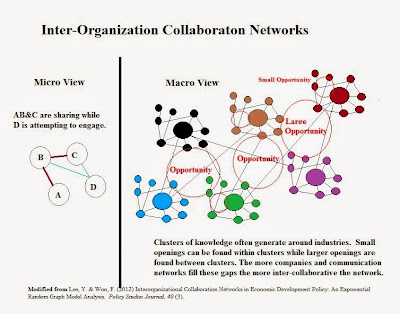A publication in the Policies
Studies Journal by Lee and Fejock (2012) helps to explain how
collaboration networks cluster together to enhance product and service
development. These networks move to enhance inter-organizational collaboration
and can create economic improvement. Their work suggests that the micro aspects
of such collaboration have not been fully analyzed but that the system appears
to be based on trust.
Three
mechanisms for collaborative alternative governance include centralized
authority, mutually binding contracts, and network embeddedness (Feiock,
2009). Each comes with their own
advantages and disadvantages. The greatest amount of flexibility lay in the
embeddedness model as it relies on a more social, economic and relationship oriented
model without the rigidity of formal oversight (Foiock, 2007).
Each of the actors within this approach maintains a
level of autonomous effort but is still part of a general network that lends
support. These collaborative networks are based on purposeful activities that
forge relationships in an effort to solve problems through the creation of
solutions by putting forward the best use of knowledge, time resources and
competition (Agranoff & McGuire, 2003).
Organizations with limited resources are more likely
to work together. Under the concept of Dependency Theory, the more limited the
resources the more they would want to work together to survive (Pfeffer &
Salancik, 2003). The report does not make the statement that all organizations
have limited resources and when that perspective is widened to international
competition those limitations become more acute.
In order to hedge their risks and improve upon their
information such organizations will attempt to develop relationships based on
trust and information with those partners likely to complement each other
(Gulati & Gargiulo, 1999). In this effort, they find those with intrinsic
and operational similarities. They use the information and collaboration to
improve upon their product and service offerings while having access to talent.
As an essential element trust followed by financial
arrangements bind the system into a coherent whole. If that trust is broken
individual businesses may find them punished through a lack of collaborative
effort, disappearance of personal connections, lost contracts, and a more
hostile environment. Those that are willing to work with others and be
equitable about these relationships will gain from the system.
The authors found that organizations seek to find a
place within the network where they can forge collaborative efforts by finding
holes in the information networks to increase potential revenue and reduce
costs. As organizations interrelate, they create stable and preferential
relationships based upon trust, commitment, and shared goals. They do this
through engaging in densely clustered networks that are capable of maintaining
commitments to collective solutions (Putnam, 1995).
It is beneficial to think of these information holes,
as places were new products and services have not recognized or developed. By
wedging themselves into these holes, they have the support of other players
within the market and can use their knowledge to enhance their own. The
surrounding companies use their new products and services to enhance their own.
Likewise, participation in such networks helps to reduce uncertainty in the
market, increase development, gain access to information, and find useful
connections for economic development. Economic hubs are often seen as the
development of these networks across multiple corporate, governmental, and
non-profit sectors.
Agranoff, Robert, and Michael
McGuire. 2003. Collaborative Public Management. Washington, DC:Georgetown
University Press.
Foiock , R. (2007). “Rational
Choice and Regionalism.” Journal of Urban Affairs 29 (1): 47–63.
Foiock, R. (2009). “Metropolitan
Governance and Institutional Collective Action.” Urban Affairs Review 44
(3):356–77.
Gulati, R. and Gargiulo, M. (1999).
Where Do Interorganizationl Networks Come From?
American
Journal of.”
Sociology 104 (5): 1439–93.
Lee, Y. & Fejock, W. (2012) Interorganizational
Collaboration Networks in Economic Development Policy: An Exponential Random
Graph Model Analysis. Policy
Studies Journal, 40 (3).
Pfeffer, J. and Salancik, G. (2003).
The External Control of Organizations: A Resource Dependence Perspective.
Stanford: Stanford Business Books.
Putnam,
R. (1995). Bowling Alone. Journal of Democracy, 6 (1): 65–78.
